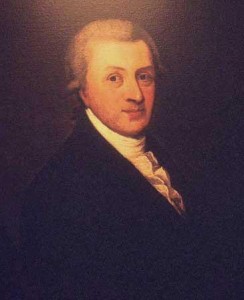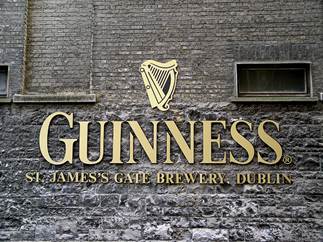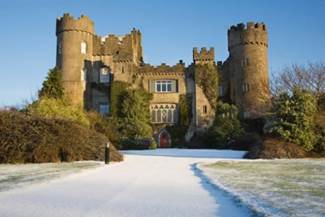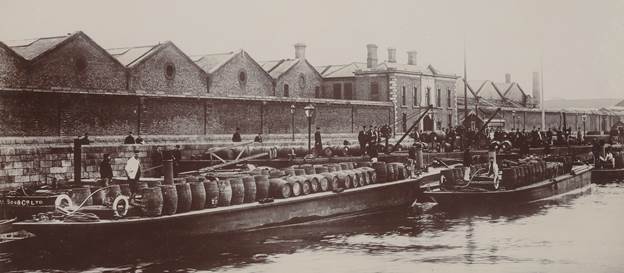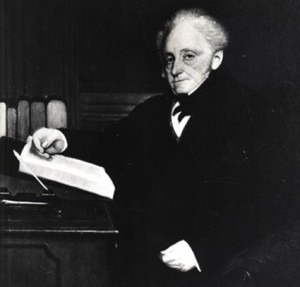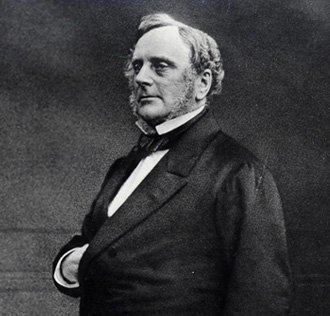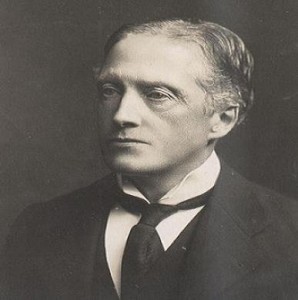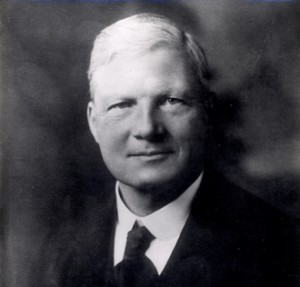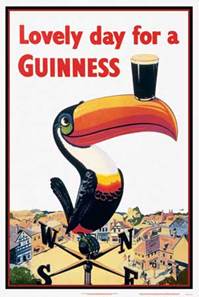| This Week’s Topic… | |

Best viewed in
|
The 9,000 Year Lease Ireland's best-known Irishman, his name and signature in every household and village in Ireland, and many abroad (including our Band!), is also the least known. Part of Dublin life for over two centuries, both family and brewery has passed into legend, but their origins have been obscured.
Arthur Guinness's (shown above) place and date of birth are subject to speculation. His gravestone in Oughterard, County Kildare says he died on 23 January 1803, at age 78, indicating that he was born some time in 1724 or very early in 1725. This contradicts the date of 28 September 1725 chosen by the Guinness Company in 1991, apparently to end speculation about his birthdate. The place of birth was perhaps his mother's home at Read homestead at Ardclough County Kildare. Regardless, Arthur Guinness was born into an Irish Protestant tenant-farmer family. His father, Richard Guinness, was Land Steward to Dr. Arthur Price, Archbishop of Cashel. Part of Richard’s duties was to supervise the brewing of beer for the workers on the estate and it is probable that young Arthur first learnt the art of brewing from his father. Dr. Price became Arthur’s godfather. In his will, Dr. Price left £100 each to Arthur and his father in 1752. Guinness invested the money and in 1755 had a brewery at Leixlip, north-east County Kildare, Ireland. Arthur asked Richard, his younger brother, to help him to conduct business. And business has gone so well that three years later, Arthur decided to move to Dublin to open a brewery. In 1759, in the southwest of the city, he found an old dilapidated brewery on 4 acres, named St. James’s Gate Brewery, which he agreed to lease for just £ 45 a year from the descendants of Sir Mark Rainsford for almost endless time – 9000 years effective from 31 December 1759. The premises at the time comprised of four acres with a copper, a kieve, a mill, two malt houses, stabling for twelve horses and a loft to hold 200 tons of hay. However, the lease is not valid in the modern day, because the brewery has expanded beyond the original 4-acre site, and consequently bought out the property.
In 1761 Arthur Guinness married Olivia Whitmore in St. Mary’s Church in Dublin. They had 21 children and 10 of them lived to adulthood. Since 1764 the family lived at Beaumont House, which Arthur had built on a farm of 51 acres. Now it’s the estate of Beaumont Convalescent Home, behind the main part of Beaumont Hospital, between Raheny and Santry in north County Dublin.
Beaumont (meaning beautiful hill) was named by him and the later Beaumont parish copied his original name. In his later years he lived at Mountjoy Square in Dublin, which was then in the process of being built in the style of elegant Georgian architecture. Three of his sons were also brewers, and his other descendants eventually included missionaries, politicians, and authors, including Os Guinness. On 19 May 1769, Guinness first exported his ale: he shipped six-and-a-half barrels to Great Britain. Arthur Guinness started selling the dark beer porter in 1778. The first Guinness beers to use the term were Single Stout and Double Stout in the 1840s. Throughout the bulk of its history, Guinness produced only three variations of a single beer type: porter or single stout, double or extra and foreign stout for export. Already one of the top-three British and Irish brewers, Guinness's sales soared from 350,000 barrels in 1868 to 779,000 barrels in 1876. In October 1886 Guinness became a public company, and was averaging sales of 1,138,000 barrels a year. This was despite the brewery's refusal to either advertise or offer its beer at a discount. Even though Guinness owned no public houses, the company was valued at £6 million and shares were twenty times oversubscribed, with share prices rising to a 60% premium on the first day of trading.
Arthur Guinness started producing the dark beer only in 1799. The production of the dark beer with creamy foam originated in 1799 that further made the company one of the symbols of Ireland. Four years later after this momentous event, at age of 78, Arthur Guinness died. As a legacy to their children businessman left 25,000 pounds, which by today’s standards would amount to about 865,000 pounds.
After father’s death the business was managed by three of his sons – Arthur II (above), Benjamin and William. Of course, the company was led by Arthur II, 35, as since childhood he helped his father in growing of his dream and he knew its all ins and outs. The company’s sales were approximately 809,000 gallons of beer a year – impressive, but it was only the beginning. By all achievements Arthur II surpassed his father. Statistics says that during the management of his son, annual sales were growing by at least 10%. Of course, there were some problems when Napoleon started the war in Europe. The war led to an economic crisis and a slight decline in sales, but it did not cause serious problems to Guinness Company. Arthur Guinness II died on June 9, 1855 in Dublin, Ireland. And if to convert the amount of Arthur’s II monetary status by modern standards it would exceed 9 million pounds.
Benjamin Lee, above, (November 01, 1798 – May 19, 1868) took sole control of company. He was born in Dublin and was the third son of Arthur Guinness II and his wife Anne Lee and a grandson of the founder of the Guinness brewery – Arthur Guinness. He had been leading Guinness brewery business for 13 years. During this time he managed not only to seriously boost Guinness’ sales, but also to become the mayor of Dublin in 1851. In 1967, his contributions were assessed by the Government, which awarded Guinness with the title of Baronet. And when the Sir Benjamin Lee Guinness, 1st Baronet died, his fortune was estimated at 65 million pounds by today’s standards. The dynasty continued to prosper and move up the social ladder.
After Benjamin’s death, Guinness was headed by another member of the famous family – Edward Cecil, above, (November, 10 1847 – October 7, 1927). Edward was born in Clontarf, Dublin. He graduated from Trinity College Dublin with Bachelor of Arts in 1870. Edward Cecil Guinness was chief executive at the Guinness brewery up until 1889. Later he became the chairman of the board, managing the largest brewery business on the globe on 64 acres. By the end of 1886 he managed to become a multi-millionaire, by floating two-thirds of the Guinness Company on the London Stock Exchange for £6,000,000 before he retired. Perhaps the most important event for the company during the management of Edward Cecil was that the company finally went public.
Rupert Guinness, 2nd Earl of Iveagh (March 29, 1874 – September 14, 1967) was perhaps the last one of the dynasty of Guinness, who was seriously engaged in the company by playing a really essential role in it. It was during Rupert’s management that the Guinness World Records published. After the Second World War, the Guinness Company was led only by outsourced managers. Members of the dynasty moved from direct management of the company. Fortunately, it had no effect on quality.
By 1900 the brewery was operating unparalleled welfare schemes for its 5,000 employees. By 1914, Guinness was producing 2,652,000 barrels of beer a year, which was more than double that of its nearest competitor Bass, and was supplying more than 10% of the total UK beer market. In the 1930s, Guinness became the seventh largest company in the world. The company has had its headquarters in London from 1932 onwards.
Before 1939, if a Guinness brewer wished to marry a Catholic, his resignation was requested. According to Thomas Molloy, writing in the Irish Independent, "It had no qualms about selling drink to Catholics but it did everything it could to avoid employing them until the 1960s."
Guinness brewed their last porter in 1973. In the 1970s, following declining sales, the decision was taken to make Guinness Extra Stout more "drinkable". The gravity was subsequently reduced, and the brand was re-launched in 1981. Pale malt was used for the first time, and isomerized hop extract began to be used.
Guinness merged with Grand Metropolitan plc in 1997, and is now part of the British based multinational alcohol conglomerate Diageo. Due to controversy over the merger, the company was maintained as a separate entity within the Diageo and has retained the rights to the product and all associated trademarks of Guinness.
The Guinness brewery in Park Royal, London closed in 2005. At the time, it was the largest and most productive brewery in the world. The production of all Guinness sold in the UK and Ireland was moved to St. James's Gate Brewery, Dublin.
There was a pelican portrayed on the first advertising Guinness poster, who was doing his best to hold a pint of beer on his beak. This was followed by an even more successful series of posters with a depicted ostrich, with the stuck pint of beer in the throat. It was an interesting move. The company emphasized that the essence of the advertising message was very simple. It turns out that even ostrich understands how valuable the beer of Guinness is and that is why he managed to swallow a cup, so it could not get anyone else. This hard job was done by a well-known artist of the time – John Gilroy, who explained the meaning of the art print. Studies claim that Guinness can be beneficial to the heart. Researchers found that "'antioxidant compounds' in the Guinness, similar to those found in certain fruits and vegetables, are responsible for the health benefits because they slow down the deposit of harmful cholesterol on the artery walls." That’s my story and I’m sticking with it. Guinness ran an advertising campaign in the 1920s which stemmed from market research – when people told the company that they felt good after their pint, the slogan was born – "Guinness is Good for You". To further honor Arthur Guinness's legacy, in 2009 Guinness & Co. established the Arthur Guinness Fund (AGF). An internal fund set up by the Company, its aim is to enable and empower individuals with skills and opportunities to deliver a measured benefit to their communities. Guinness has donated more than €7 million to the Fund since its inception. |
